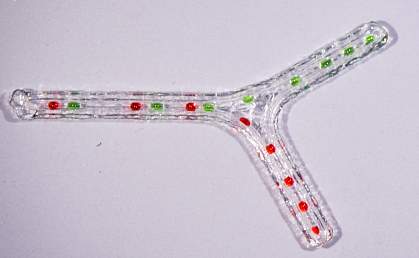You are here
September 28, 2015
Repairing Nerve Pathways With 3-D Printing
At a Glance
- A novel 3-D printing approach was used to create custom scaffolds that helped damaged rat nerves regenerate and improved the animals’ ability to walk.
- With further development, the technique might one day be used to create a range of customized scaffolds to aid tissue regeneration.

The peripheral nerves extend from the brain and spinal cord out to the rest of the body. They can be damaged in various ways, including disease and traumatic injuries such as car accidents and battlefield wounds.
Treatment for peripheral nerve damage depends on the specific injury. Nerve regeneration requires a complex interplay of physical and chemical cues. Current techniques for nerve repair center on grafts, in which a portion of a healthy nerve is taken (harvested) from another part of the body to replace the damaged section. However, grafts require harvesting surgery and are also limited by size and geometry. They can cause a host of problems at the donor site as well, including harmful immune responses, chronic pain, and sensory loss.
A team led by Dr. Michael C. McAlpine at the University of Minnesota, Blake N. Johnson at Virginia Tech, and Dr. Xiaofeng Jia at the University of Maryland and Johns Hopkins University has been investigating techniques for guiding nerve regeneration. Previous attempts have been limited to linear structures that don’t mimic naturally branching nerves. To create complex, customized structures, the team turned to 3-D printing, in which an object is “printed” by laying down successive layers of material in a pattern based on a digital model. The work was funded in part by NIH’s National Institute of Neurological Disorders and Stroke (NINDS) and National Heart, Lung, and Blood Institute (NHLBI). It appeared online in Advanced Functional Materials on September 18, 2015.
The team selected the sciatic nerve in rats as a model for regeneration, as it contains a complex, mixed nerve (sensory and motor) system. The researchers removed a section and prepared a cast of the nerve to image using a 3-D light-scanning technique. After conducting scans from various angles, they assembled the images into a 3-D model of the nerve pathway. This model then served as a template for a specialized, custom-built 3-D printer to manufacture a structure mimicking the exact geometry of the original nerve tissue.
The team demonstrated they could use the approach to create anatomically accurate nerve pathways. They verified they could use various materials known to be safe for use in the body, including silicone. Incorporating microgrooves in the structure helped guide nerve fiber growth. They found they could also help direct sensory and motor nerve branches to grow along separate paths by incorporating specific biochemical cues into different parts of the structure.
Once they developed the approach in laboratory experiments, they tested how well the technique could regenerate complex nerve gaps in a rat model. They created 10 mm gaps in the sciatic nerve and treated the animals with customized, 3-D printed nerve scaffolds. Over a 3-month period, the rats’ ability to walk improved significantly.
The team also showed that conventional imaging technologies, such as CT scans and MRI, could be used to make 3-D models of nerves in the body.
“This represents an important proof of concept of the 3-D printing of custom nerve guides for the regeneration of complex nerve injuries,” McAlpine says. “Someday we hope that we could have a 3-D scanner and printer right at the hospital to create custom nerve guides on site to restore nerve function.”
—by Harrison Wein, Ph.D.
Related Links
- New 3D-Printed Scaffolds
- Paralyzed Men Gain Movement Without Surgery
- Device Restores Movement to Paralyzed Limbs
- 3-D Printing of Working Bionic Ears
- Peripheral Neuropathy
References: 3D Printed Anatomical Nerve Regeneration Pathways. Johnson BN, Lancaster K Z, Zhen G, He J, Gupta M K, Kong YL, Engel EA, Krick KD, Ju A, Meng F, Enquist LW, Jia X, McAlpine MC. Adv. Funct. Mater. 2015 Sep 18. doi: 10.1002/adfm.201501760. [Epub ahead of print].
Funding: NIH’s National Institute of Neurological Disorders and Stroke (NINDS) and National Heart, Lung, and Blood Institute (NHLBI); National Science Foundation; Maryland Stem Cell Research Fund; Defense Advanced Research Project Agency; and the Grand Challenges Program at Princeton University.
